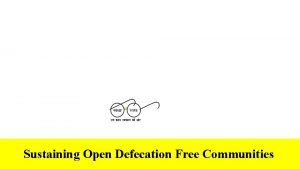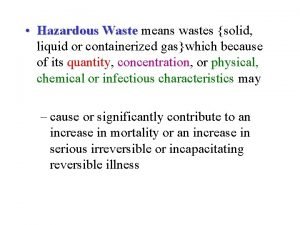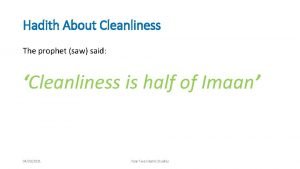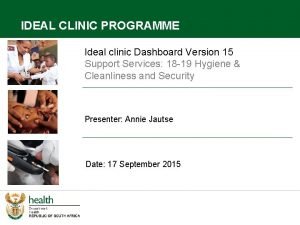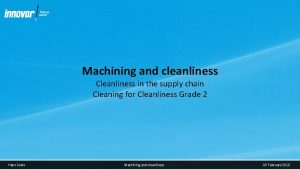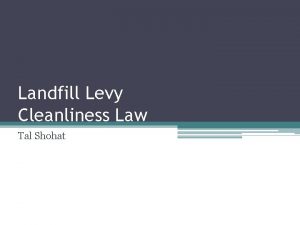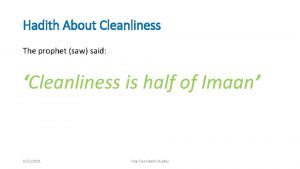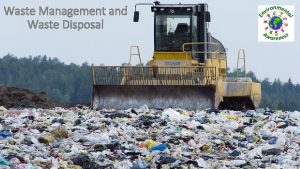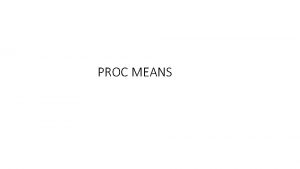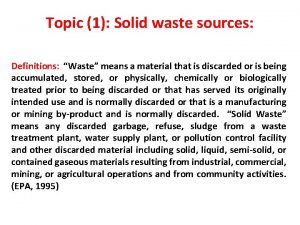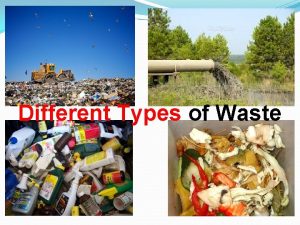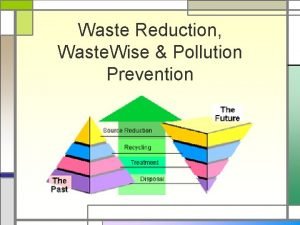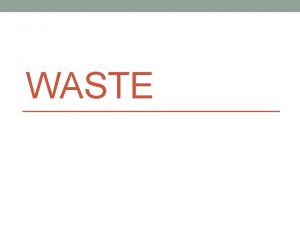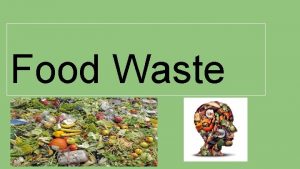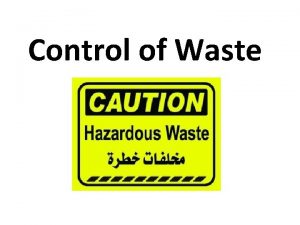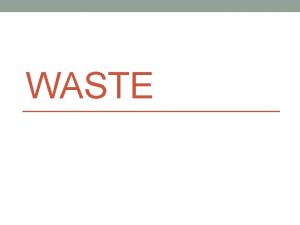CLEANLINESS AND WASTE PRACTICES CLEANLINESS Cleanliness means that




















- Slides: 20

CLEANLINESS AND WASTE PRACTICES

CLEANLINESS Cleanliness means that there is no dirt, no dust, no stains, no bad smells. The goals of cleanliness are health, beauty, absence of offensive odor and to avoid the spreading of dirt and contaminants to oneself and others. Cleanliness gives rise to a good character by keeping body, mind, and soul clean and peaceful. Maintaining cleanliness is the essential part of healthy living because it is the cleanliness only which helps to improve our personality by keeping clean externally and internally.

CLEAN HABITS : One should always wash their hands before eating. You should brush your teeth at least twice. No one should litter. Taking a bath every day is mandatory. Washing hands after playing is also very essential. Covering your nose while sneezing or covering your mouth while yawning is also necessary. If someone has pests and rodents in their house, they must get rid of them as soon as possible. One must always cover their food.

Personal Grooming: It involves cleaning and maintaining the body parts and look good. Taking bath, brushing and flossing teeth, combing, washing hands whenever required, cutting nails and hair at regular intervals are some habits that are important part of personal cleanliness. AREA'S OF CLEANLINESS Keeping ones thoughts clean is as important as physical cleanliness. 2. Home: Next to personal cleanliness comes keeping the dwelling place neat and clean. Starting with disposing the garbage on a daily basis, it includes cleaning up all rooms on a regular basis, maintaining bedcovers and curtains, trimming the interior and exterior garden, keeping the kitchen sink and toilet free of unpleasant smell, insects etc. It also includes proper disposal of solid and liquid waste into the municipal dustbin and drainage system.

Workplace: Since major part of the productive day is spent in the workplace, it is necessary to keep it very clean. Apart from the basic cleanliness activities done at home, the workplace needs additional application of disinfectants, air filters, and waste disposal systems to maintain hygiene and dignity. It needs still more attention at Hospitals, Restaurants and like industries. Public Places: Living in communities, it is important to keep public places like roads, beaches, parks etc. neat and clean. If each citizen becomes responsible and could show the same care that is taken for home and workplace, then the city and the entire country would have a clean environment to live, work and play.

CHALLENGES IN CLEANLINESS Lack of resources can inhibit cleanliness. In order to maintain cleanliness, there is need for water, detergents and other supplies like cleaning equipment. Another challenge is the availability of labor. Since cleaning is tasking and requires effort from people, some people opt out and cleanliness will not be achieved.

What is waste disposal practice? waste disposal. Removing and destroying or storing damaged, used or other unwanted domestic, agricultural or industrial products and WASTE DISPOSAL AND MANAGEMENT substances. Disposal includes burning, burial at landfill sites or at sea, and recycling. What are the ways of disposal of waste? Waste Disposal Practices. There are eight major groups of waste management methods, each of them divided into numerous categories. Those groups include source reduction and reuse, animal feeding, recycling, composting, fermentation, landfills, incineration and land application.

Reuse Instead of throwing things away that you might not use anymore, why not give them to someone else? THE 3 R’S Turn broken crayons into pretty candles to give to teachers, family members or just keep in your room (with adult permission, of course). Use old jars as tea light holders for special events. Buy reusable lunch containers and use those instead of plastic wrap or disposable baggies. Stop throwing out old and mismatched socks, and instead make a fuzzy sock snake that you or another kid will love cuddling. Turn used paper into art supplies or scrap paper for making shopping lists.

Recycle Sometimes, you can’t find a second use for something, and that’s okay. If an item truly is waste, and you can’t cut that item out of your life in the first place, it’s time to recycle. Think cereal boxes or beverage containers Check out the list of some of the many items that can be recycled below: • Cardboard • Aluminium cans • Paper • Newspaper • Plastic bottles • Plastic Bags • Metal • Magazines • Glass bottles and jars

Reduce Both grownups and kids struggle with such questions, and it takes effort to begin answering them differently. That’s okay; just practice. You can begin reducing the amount of waste you produce by choosing to buy products that do not create excess waste that later has to be added to landfills.

What is Dry Waste? Paper, plastics, metal, glass, rubber, thermocol, Styrofoam, fabric, leather, rexine, wood – anything that can be kept for an extended period without decomposing. What is wet waste? Wet waste consists of kitchen waste – including vegetable and fruit peels and pieces, tea leaves, coffee grounds, eggshells, bones and entrails, fish scales, as well as cooked food (both veg and non veg).

Why should I do it? 1. So that it reduces waste that reaches landfills and reduces pollution to air and water 2. So that different processes composting, recycling, incineration can be applied to different kinds of waste How do I practice waste management at home? 1. Keep separate containers for dry and wet waste in the kitchen 2. Keep two bags for dry waste collection paper and plastic , for the rest of the household waste 3. Keep plastic from the kitchen clean and dry and drop into the dry waste bin. Keep glass /plastic containers rinsed of food matter 4. Send wet waste out of the home daily. Store and send dry waste out of the home , once a week. 5. Keep a paper bag for throwing the sanitary waste

4 5 years Kids this age can usually speak clearly and use complex sentences. Have a greater attention span DEVELOPMENT MILESTONES (4 9 years) Follow 2 3 part commands Recognize familiar words and signs Take care of personal needs without much help Enjoys playing with other friends Understands rules of games Learns the idea of sharing Understands and obeys rules Can brush their teeth and wash their hands effectively.

6 7 years Are able to write and draw with greater control and precision Have better balance and coordination Uses more logic and reason in thinking Refine hand eye coordination Can combine motor skills Will become more adept at drawing and are interested in such projects. Memory is continuous and organized Learns the concept of taking turns, sharing.

8 9 years Focus and attention span improves Can completely groom and dress themselves Likes game and competition Able to take a wide variety of chores and responsibilities Ability to reason develops Works cooperatively towards shared goals

What do you store your household waste in? a)plastic bags b)cardboard boxes c)dustbin d)no storage direct disposal to dump Do you know about dry and wet waste? Do you segregate it and dispose it in separate containers? a)yes b)no Are there any large bins in your area? a) yes b) no How do you feel that the cleanliness in your local environment is? a) very good b) good c) okay d) bad QUESTIONNAIRE What kind of waste do you find in your local environment? a) human faeces b) animal faeces c) stagnation of waste d) all of these In your opinion which of these is a priority concern about waste in the area ? a) littering and looks bad b) effect on human health c) effect on environment d) other____ What form of drinking water do you use? a) boiled water b) filtered water c) RO treated d) original form/tap water Where do you keep the water and food? a) open environment b) protected environment c) semi protected environment d) b or c Which of the following diseases are spread by not maintaining cleanliness and hygiene? a) cholera b) hepatitis B c) dengue d) all With the increasing spread of various viruses do you thinking maintaining cleanliness without you and around you is important? a) yes b) no

1. I wash my hands before having food a) Always 2. I use soap to wash my hands b) Frequently c) Sometimes d) Never a) Always b) Frequently c) Sometimes d)Never 3. I wash my hands after using the toilet a) Always PERSONAL HYGIENE QUESTIONNAIRE 4. I take bath daily 5. I wear washed clothes a) Always b) Frequently c) Sometimes d) Never 6. I walk to school without any footwear a) Always 7. I brush my teeth twice a day 8. I cut my nails regularly 9. I always drink protected water 10. I take bath after playing a) Always b) Frequently c) Sometimes d) Never b) Frequently c) Sometimes d) Never

VISUAL COMMUNICATION


 Phân độ lown
Phân độ lown Block xoang nhĩ độ 2
Block xoang nhĩ độ 2 Thơ thất ngôn tứ tuyệt đường luật
Thơ thất ngôn tứ tuyệt đường luật Thơ thất ngôn tứ tuyệt đường luật
Thơ thất ngôn tứ tuyệt đường luật Chiến lược kinh doanh quốc tế của walmart
Chiến lược kinh doanh quốc tế của walmart Tìm độ lớn thật của tam giác abc
Tìm độ lớn thật của tam giác abc Con hãy đưa tay khi thấy người vấp ngã
Con hãy đưa tay khi thấy người vấp ngã Tôn thất thuyết là ai
Tôn thất thuyết là ai Gây tê cơ vuông thắt lưng
Gây tê cơ vuông thắt lưng Sau thất bại ở hồ điển triệt
Sau thất bại ở hồ điển triệt Mission and vision of cleanliness
Mission and vision of cleanliness Waste means
Waste means Quadrilateral pentagon hexagon octagon
Quadrilateral pentagon hexagon octagon Meta means change and morph means heat
Meta means change and morph means heat Definition of biodiversity conservation
Definition of biodiversity conservation Meta means in metamorphism
Meta means in metamorphism Hadith about cleanliness
Hadith about cleanliness Astm d 7393
Astm d 7393 Purpose of cleanliness
Purpose of cleanliness Shell cleanliness shell soundness shell
Shell cleanliness shell soundness shell Cleanliness
Cleanliness










